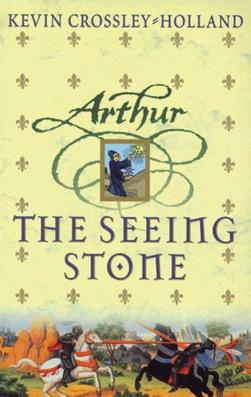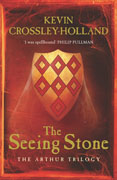The Seeing Stone facts for kids

Front cover of first edition
|
|
| Author | Kevin Crossley-Holland |
|---|---|
| Cover artist | Marc Adams |
| Country | United Kingdom |
| Language | English |
| Series | Arthur trilogy |
| Genre | Children's historical fantasy |
| Publisher | Orion Publishing Group |
|
Publication date
|
August 2000 |
| Media type | Print (hardback & paperback), audiobook (tape and CD) |
| Pages | 324 pp (first edition) |
| ISBN | 1-85881-397-2 |
| OCLC | 44915913 |
| LC Class | PZ7.C88284 Sf 2001 |
| Followed by | At the Crossing-Places |
The Seeing Stone, also known as Arthur: The Seeing Stone, is an exciting historical novel for young readers. It was written by Kevin Crossley-Holland and came out in 2000. This book is the first part of the Arthur trilogy, which includes three books published between 2000 and 2003.
The story mainly takes place in a region called the March of Wales around the years 1199 and 1200. It follows a young boy named Arthur de Caldicot. He discovers a special "Seeing Stone" that lets him watch the early life of the famous King Arthur. Both Kevin Crossley-Holland and The Seeing Stone won important awards, including the Guardian Children's Fiction Prize and the Tir na n-Og Award.
This book series tells the classic Arthurian legend in a new way. The story is told by Arthur de Caldicot himself, so you read it from his point of view. Both Arthur's real-world adventures and the events he sees in the stone help to retell the famous legend.
Contents
The Story of The Seeing Stone
Arthur's Life in the Real World
The story starts in 1199, just before the Fourth Crusade began. Our main character, Arthur de Caldicot, is thirteen years old. He is the second son of a knight who lives in Caldicot manor, located in the "Middle Marches" of Wales.
Much of this first book shows the challenges of everyday life in the Middle Ages. A big problem for Arthur is that he's the second son. This means he won't inherit his father's land. To make his own way, he needs to become a squire (a knight's assistant) and then a knight himself. He hopes to earn his own land and manor one day.
Arthur faces a few difficulties. He's not very good at "yard-skills" like jousting and sword fighting. Also, he is left-handed, which was seen as unusual back then. He has to learn to joust and fence with his left hand. His father also wants him to become a scribe (someone who copies documents) because Arthur is good at reading and writing.
Things change on his fourteenth birthday. Arthur learns that his "uncle" Sir William de Gortanore is actually his real father! This means Arthur is now the heir to a large manor. However, this news brings sad truths. It seems his mother's husband died because of Sir William, who was very jealous. This discovery also breaks off Arthur's betrothal to Grace, Sir William's daughter. Since Grace is now his half-sister, they cannot marry. The book ends with Arthur becoming a squire for Stephen de Holt, the Lord of the Middle Marches.
Adventures in the Seeing Stone
Early in the story, the wizard Merlin gives Arthur de Caldicot the special "Seeing Stone." Merlin warns him that the stone will stop working if Arthur shares its secrets with anyone else.
Through this stone, Arthur watches the life of the legendary King Arthur. He sees King Arthur's journey until he becomes the King of Britain. The visions begin with the marriage of King Uther and Ygerna, who become King Arthur's parents. Merlin then takes the baby Arthur to be raised by a foster family. Years later, after King Uther dies, Arthur becomes king.
Many people Arthur sees in the stone look exactly like people in his own life. The most striking resemblance is between Arthur de Caldicot and the young King Arthur himself. This makes Arthur de Caldicot wonder if the King Arthur in the stone is actually him in the future. This idea grows stronger when he learns on his birthday that his own parents are actually his foster parents, just like for the young King Arthur. Eventually, it becomes clear that King Arthur lives in a parallel universe. Events in both worlds seem to mirror each other.
Awards and Recognition
The Seeing Stone received several important awards:
- Guardian Children's Fiction Prize: Kevin Crossley-Holland won this special award. It's a one-time prize given by a group of British children's writers for the best children's book by an author who hasn't won it before. The 2001 prize was unique because it covered books published over 21 months (2000–2001) to change how the award schedule worked.
- Tir na n-Og Award: This Welsh award recognized The Seeing Stone as the best English-language book for young people that year. It was chosen because it had a real "Welsh background."
- Nestlé Smarties Book Prize: The book was a bronze runner-up for the Smarties Prize in the 9–11 years age group.
- 2000 Whitbread Awards: The Seeing Stone was also shortlisted for the children's book category of the Whitbread Awards in 2000.
The Arthur Trilogy
The Seeing Stone is the first book in a series called the Arthur trilogy. The three books together are about 1100 pages long in their first hardcover editions.
- The Seeing Stone (Orion, August 2000)
- At the Crossing-Places (Orion, August 2001)
- King of the Middle March (Orion, October 2003)
In the UK, the first book was released as a printed book and on audio tape. A paperback version came out in June 2001, and an audio CD was released in July 2003. Another paperback edition with new cover art was published in September 2006.
The first US edition was published in 2001 by Scholastic, under their imprint Arthur A. Levine Books. The book has also been translated into many other languages, including Danish, Finnish, German, Spanish, Norwegian (all in 2001), Catalan, French, Italian (in 2002), Hebrew (2004), Serbian (2006), and Romanian (2008).


